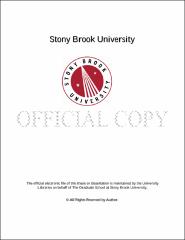| dc.identifier.uri | http://hdl.handle.net/11401/77318 | |
| dc.description.sponsorship | This work is sponsored by the Stony Brook University Graduate School in compliance with the requirements for completion of degree. | en_US |
| dc.format | Monograph | |
| dc.format.medium | Electronic Resource | en_US |
| dc.language.iso | en_US | |
| dc.publisher | The Graduate School, Stony Brook University: Stony Brook, NY. | |
| dc.type | Dissertation | |
| dcterms.abstract | Emergence of online social networks has transformed how people interact with digital media. Any user is a consumer and a publisher of media content, such as texts, images, or videos, in the online community. In such an environment, it is crucial to develop technology to help people by organizing and utilizing plethora of media content to meet the community demands. To this goal, this dissertation studies and tries to establish computational approaches to understand networked content, using large-scale data from a real-world online fashion network, Chictopia. This study focuses on two major challenges of fashion networks: understanding of visual content, and understanding of user behavior. The first component is the understanding of fashion pictures. This dissertation studies computer vision techniques to recognize garment items in a picture. This dissertation proposes clothing-parsing algorithms, which assign one of clothing category to every pixel. The algorithm takes advantage of the unique characteristics of fashion pictures that human pose gives a strong contextual cue in clothing parsing. The proposed approach considers two scenarios in clothing parsing. The first is to identify the location of items given an item list (localization scenario). This localization problem is formulated as a joint label assignment with respect to a probability distribution. The second scenario is to identify both kind of items and their locations (detection scenario). This dissertation proposes a data-driven approach to solve the difficulty in identifying clothing items. The empirical results show promising recognition performance in both scenarios, as well as the benefits of clothing parsing in human pose estimation. The second focus of this dissertation is the analysis of user behavior in fashion networks. Specifically, this research studies the effects of visual, textual, and social factors on content popularity. The analysis makes use of the clothing parsing techniques, as well as network and text information to predict picture popularity in both in-network and out-of-network cases. The experiments find significant statistical evidence that social factors dominate the in-network scenario, but a combination of content and social factors can help predicting popularity outside of the network. | |
| dcterms.available | 2017-09-20T16:52:30Z | |
| dcterms.contributor | Berg, Tamara L | en_US |
| dcterms.contributor | Samaras, Dimitris | en_US |
| dcterms.contributor | Ortiz, Luis | en_US |
| dcterms.contributor | Belongie, Serge. | en_US |
| dcterms.creator | Yamaguchi, Kota | |
| dcterms.dateAccepted | 2017-09-20T16:52:30Z | |
| dcterms.dateSubmitted | 2017-09-20T16:52:30Z | |
| dcterms.description | Department of Computer Science. | en_US |
| dcterms.extent | 135 pg. | en_US |
| dcterms.format | Application/PDF | en_US |
| dcterms.format | Monograph | |
| dcterms.identifier | http://hdl.handle.net/11401/77318 | |
| dcterms.issued | 2014-12-01 | |
| dcterms.language | en_US | |
| dcterms.provenance | Made available in DSpace on 2017-09-20T16:52:30Z (GMT). No. of bitstreams: 1
Yamaguchi_grad.sunysb_0771E_11794.pdf: 9139630 bytes, checksum: 1ce58be535289ab32d31ad4424e86ad1 (MD5)
Previous issue date: 1 | en |
| dcterms.publisher | The Graduate School, Stony Brook University: Stony Brook, NY. | |
| dcterms.subject | Computer science | |
| dcterms.subject | big data, computer vision, fashion network, machine learning, social network | |
| dcterms.title | Understanding Online Fashion Networks | |
| dcterms.type | Dissertation | |

